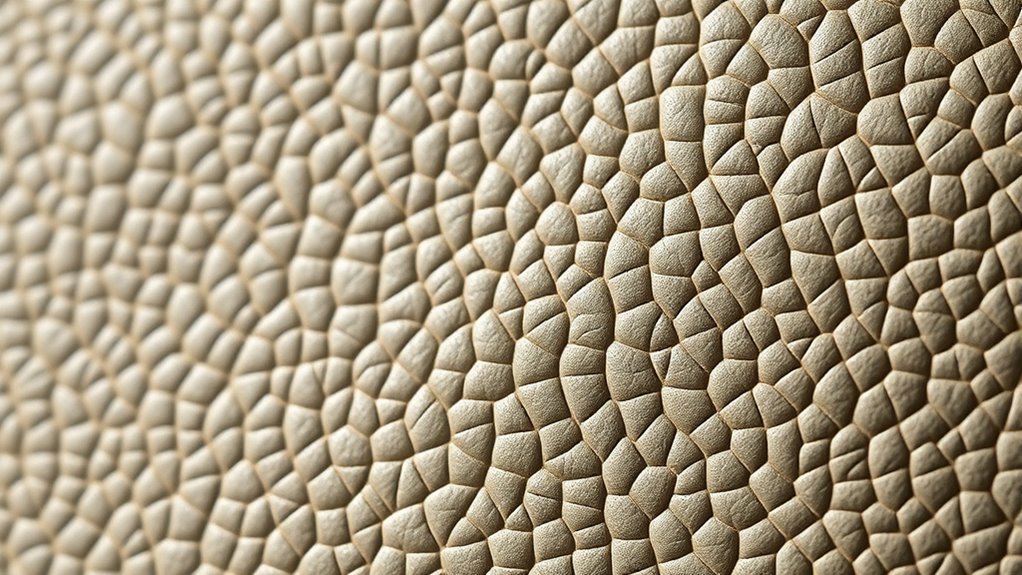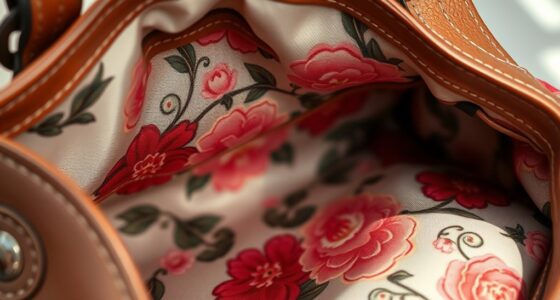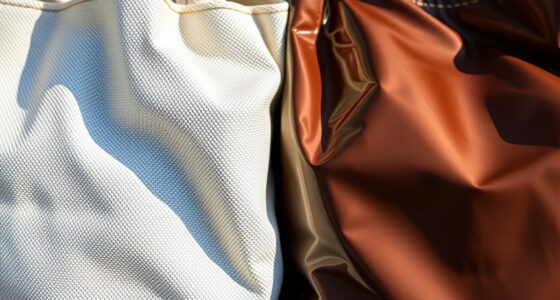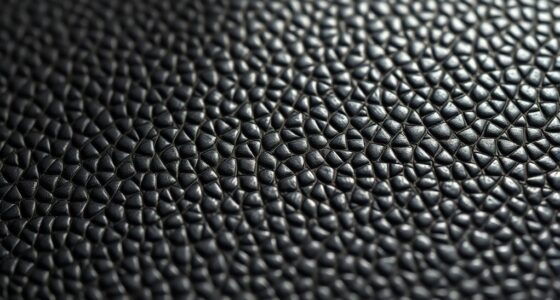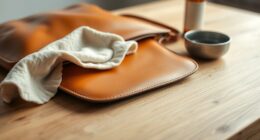Vegan leather is made without animal products, relying instead on synthetic, plant-based, or recycled materials like polyurethane, cork, and pineapple fibers. These materials are processed responsibly to guarantee durability, sustainability, and ethical standards. Certifications verify cruelty-free practices, while eco-friendly options like cork and recycled plastics reduce environmental impact. If you’re curious about how each material contributes to true vegan leather, there’s more to uncover about their sourcing, processing, and eco benefits.
Key Takeaways
- Vegan leather is made from non-animal materials such as synthetic plastics or plant-based alternatives, avoiding animal-derived components.
- It does not involve animal cruelty, supporting ethical standards and cruelty-free certification labels.
- Common materials include polyurethane, PVC, cork, pineapple fibers, mushroom leather, and recycled or upcycled textiles.
- Vegan leather’s composition ensures it is free from animal fats, skins, or other animal-derived substances.
- Sustainable practices, like using biodegradable or recycled materials, reinforce its vegan and eco-friendly identity.
Synthetic Plastics: Polyurethane and PVC
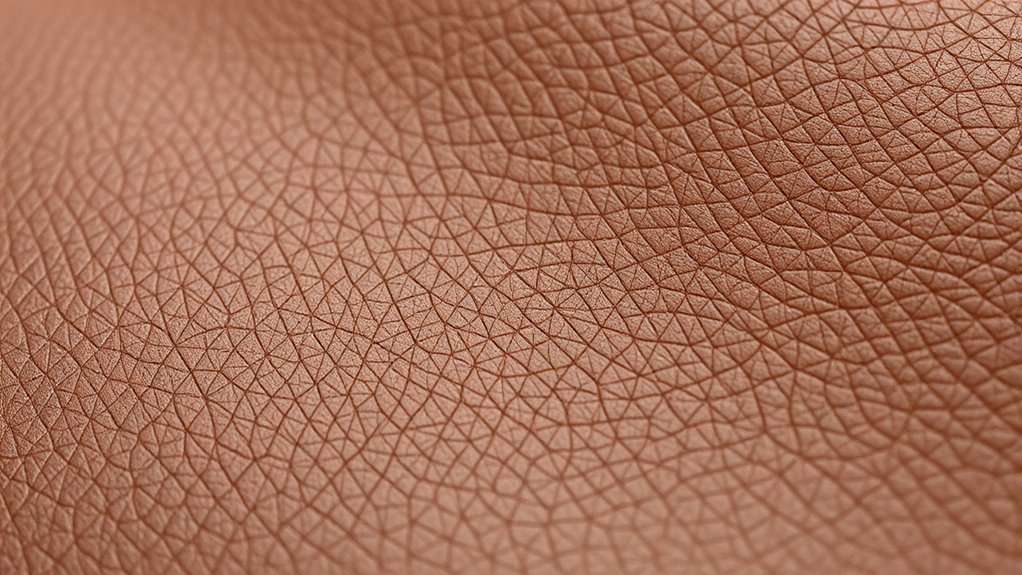
Have you ever wondered how synthetic plastics like polyurethane and PVC are used to create vegan leather? These materials are prized for their chemical stability, which helps them withstand wear and tear over time. During manufacturing processes, polyurethane is often applied as a coating or layered onto fabrics, creating a durable surface that mimics real leather. PVC, or polyvinyl chloride, is produced by polymerizing vinyl chloride gas, resulting in a flexible, resilient material suitable for vegan leather products. Both plastics are processed in controlled environments to ensure consistency and quality. Their chemical stability guarantees they resist moisture, stains, and scratches, making them practical alternatives. By understanding these manufacturing processes, you can appreciate how synthetic plastics form the backbone of many vegan leather options today.
Plant-Based Alternatives: Cork, Pineapple, and More
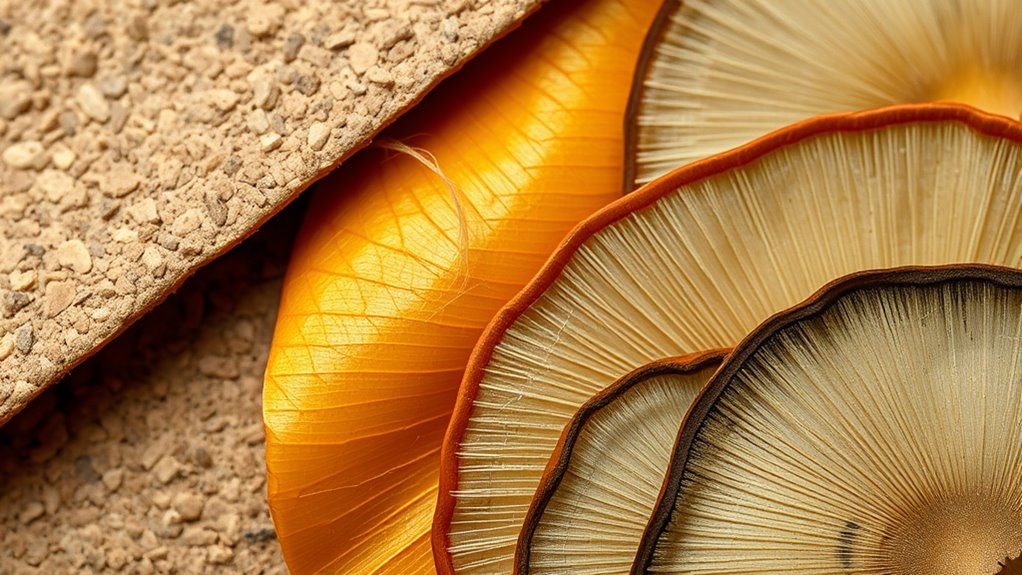
Plant-based alternatives like cork and pineapple fibers offer exciting options for vegan leather. Cork stands out for its sustainability, while pineapple fibers prove to be durable and versatile. There are also other innovative materials emerging, expanding the possibilities for eco-friendly fashion. As the industry evolves, understanding material transparency helps consumers make informed choices about ethical production processes. Additionally, staying informed about risks and regulations in the industry ensures responsible adoption of these materials. Incorporating sustainable practices across the supply chain further supports environmental preservation and ethical standards. Moreover, product certifications play a crucial role in verifying the eco-friendly claims of these materials, fostering trust among consumers. Being aware of emotional manipulation and other behaviors associated with non-ethical practices in production can help consumers advocate for fair and transparent sourcing.
Cork’s Sustainability Edge
Did you know that cork’s natural properties make it an especially sustainable choice among plant-based leather alternatives? Cork is harvested from the bark of cork oak trees without harming them, which promotes forest health and biodiversity. This sustainable harvesting process means the trees can regenerate their bark annually, making cork a renewable resource. Its lightweight, buoyant, and fire-resistant qualities add to its practicality. Additionally, cork’s renewable nature makes it an eco-friendly option that aligns with principles of sustainable resource management. Its biodegradability ensures that even at the end of its life cycle, cork-based products have minimal environmental impact. The ability to monitor and manage material cost variances effectively can further enhance the sustainability of cork production processes. Choosing cork aligns with animal rights concerns, as it’s a plant-based material that doesn’t involve animal exploitation. As vegan fashion trends grow, more brands are incorporating cork to appeal to eco-conscious consumers seeking cruelty-free options. Additionally, material sustainability is a key factor driving the adoption of cork in eco-friendly fashion. By opting for cork, you support sustainable practices and reduce environmental impact, making it a compelling choice in the shift toward more ethical, plant-based fashion.
Pineapple Fibers’ Durability
Pineapple fibers, known as Piñatex, offer a highly durable alternative to traditional leather, making them a practical choice for eco-conscious consumers. This plant fiber boasts impressive tensile strength, which helps it withstand daily wear and tear. Its durability depends on how well it’s processed and treated, but overall, it holds up well over time. When considering pineapple fibers, keep these points in mind:
- They have a strong tensile strength comparable to some animal-based leathers.
- Proper finishing enhances their resistance to water and scratches.
- The fiber’s natural properties contribute to longevity, making it suitable for accessories and footwear.
- The color accuracy of the processing methods can impact the visual appeal and consistency of the final product. Additionally, understanding the vibrational qualities of the material can help in selecting sustainable options that align with eco-friendly values.
Other Innovative Options
Aside from pineapple fibers, several other innovative materials are gaining attention as sustainable leather alternatives. Cork, for example, offers a luxurious feel that appeals to premium brands, aligning with luxury branding’s emphasis on quality and uniqueness. Its natural texture and eco-friendly harvest process boost consumer perceptions of sustainability and sophistication. Additionally, the textured surface of cork contributes to its natural aesthetic, making it desirable for high-end design. Similarly, mushroom leather (mycelium) provides durability and a soft finish, making it a compelling choice for high-end products. These materials challenge traditional views of leather, prompting consumers to see vegan options as innovative and stylish. As awareness grows, brands incorporating cork, mushroom, or other plant-based options can reshape consumer perceptions, positioning themselves as leaders in sustainable fashion without sacrificing luxury standards. This shift influences buying choices and elevates the status of plant-based alternatives. Moreover, many of these innovative options utilize renewable resources, further emphasizing their eco-friendly credentials. Understanding alternative materials helps consumers make more informed and eco-conscious decisions.
Recycled Materials and Upcycled Textiles
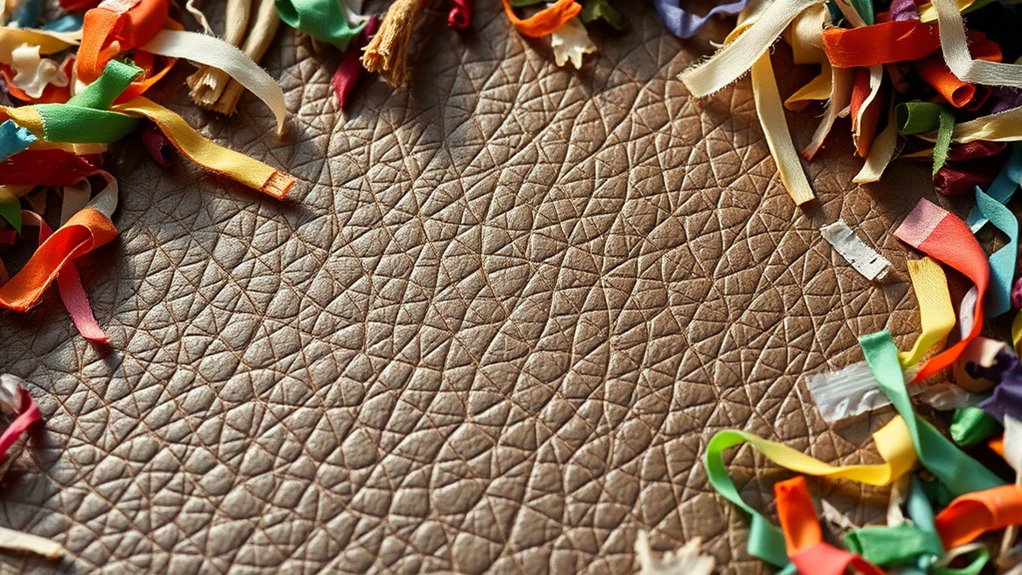
Recycled plastics are increasingly used in vegan leather, giving new life to waste materials. Upcycled textiles transform old fabrics into stylish, sustainable options for accessories and apparel. By choosing these materials, you can help reduce waste and support eco-friendly fashion. Incorporating sustainable materials that are eco-conscious can further enhance the sustainability of vegan leather products.
Recycled Plastic Content
Have you ever wondered how sustainable materials can reduce environmental impact? Recycled plastic content in vegan leather is a game-changer. It transforms discarded plastics into stylish, eco-friendly fashion options, supporting animal welfare by reducing demand for animal-derived products. Plus, it aligns with current fashion trends favoring sustainability. Using recycled plastics helps lower landfill waste and decreases the need for virgin resource extraction, which can harm ecosystems. Here are three key benefits: 1. Reduces plastic waste in oceans and landfills 2. Conserve natural resources and energy 3. Supports eco-conscious consumer choices and encourages sustainable innovation. Incorporating innovative material transformation techniques further enhances the environmental benefits of vegan leather, leveraging water pressure issues to optimize sustainable design processes.
Upcycled Textile Applications
Building on the sustainability achieved through recycled plastic content, upcycled textile applications take eco-friendly fashion a step further by transforming pre-loved fabrics into new, stylish materials. You can incorporate upcycled textiles made from discarded garments or industrial scraps, reducing waste and conserving resources. These textiles often feature vibrant, eco friendly dyes that enhance their visual appeal without harming the environment. When used in vegan leather branding, upcycled textiles create unique textures and patterns, emphasizing sustainability and creativity. This approach not only minimizes environmental impact but also appeals to conscious consumers seeking authentic, eco-friendly products. By choosing upcycled textiles, you support circular fashion, giving new life to materials that would otherwise be discarded, and reinforcing the message that vegan leather can be both stylish and sustainable.
The Role of Natural vs. Faux Leather in Vegan Products
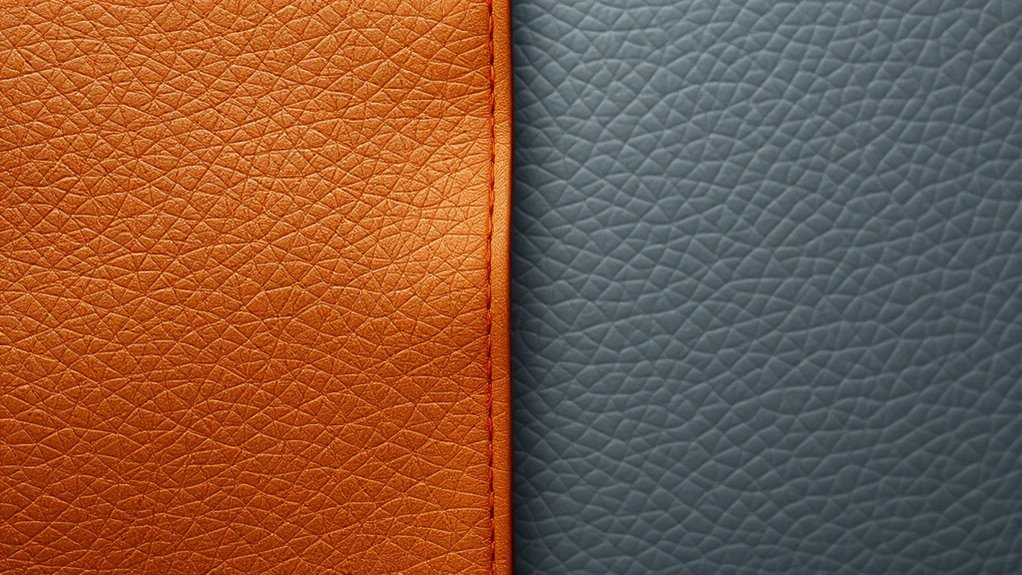
While vegan products aim to eliminate animal-derived materials, the choice between natural and faux leather plays a crucial role in shaping their sustainability and ethical appeal. Natural leather, often linked to traditional craftsmanship, can sometimes raise concerns about animal cruelty if sourced irresponsibly. Faux leather, made from synthetic materials, avoids animal cruelty but may involve environmental issues due to plastic production. Your decision impacts not only ethics but also durability and environmental footprint. Consider these key points:
Choosing between natural and faux leather impacts ethics, sustainability, and durability in vegan products.
- Natural leather supports traditional craftsmanship but can involve animal cruelty.
- Faux leather offers cruelty-free options but may have environmental drawbacks.
- Both types influence the sustainability and ethical perception of vegan products.
Your choice reflects your values and impacts the overall ethical integrity of vegan fashion.
Additives and Coatings: Enhancing Durability and Appearance

After choosing between natural and faux leather, many brands turn to additives and coatings to improve their products. These chemical treatments and surface finishes boost durability, resistance, and visual appeal. Coatings can provide water resistance and scratch protection, ensuring your vegan leather stays looking fresh longer. Additives may also prevent cracking and peeling over time. The application process involves layering finishes that enhance texture and color vibrancy while maintaining eco-friendly standards. Here’s a quick overview:
| Additive/Coating | Purpose | Environmental Impact |
|---|---|---|
| Water-based finishes | Improve water resistance | Low VOC emissions |
| UV protectants | Prevent fading | Generally eco-friendly |
| Matte/gloss coatings | Alter surface appearance | Varies, choose eco-friendly options |
| Anti-scratch layers | Increase scratch resistance | Often non-toxic |
| Top coats | Enhance shine and durability | Sustainable formulations |
Certification Labels and Ethical Standards to Watch For
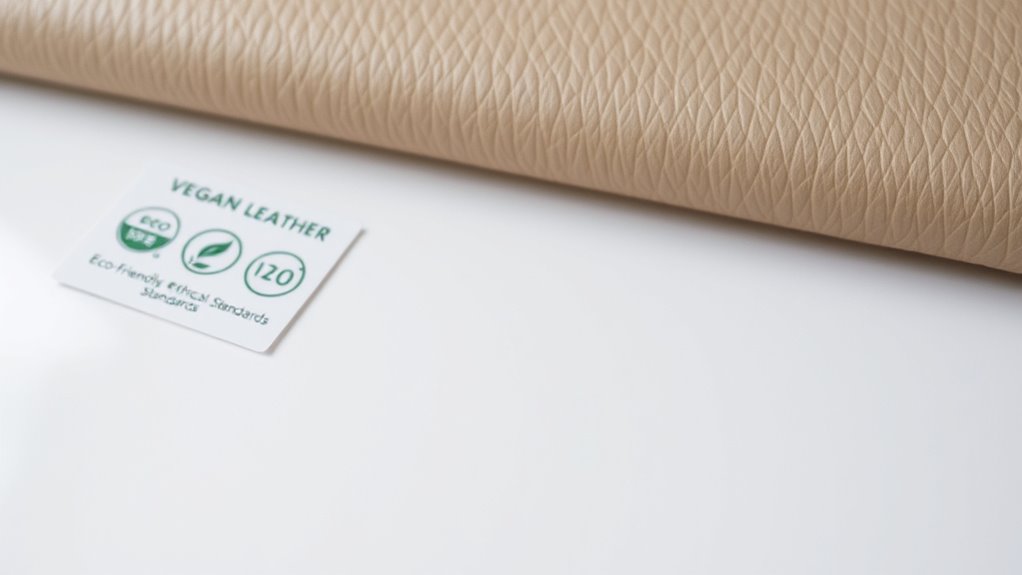
When choosing vegan leather products, paying attention to certification labels and ethical standards can help guarantee you’re making responsible choices. These labels ensure the material aligns with animal cruelty-free practices and meets certification standards for ethical sourcing. Look for reputable certifications like PETA’s “Cruelty-Free” or the Leaping Bunny logo, which verify no animal cruelty was involved. Additionally, certifications such as Fair Trade can indicate ethical production practices. Here are key points to consider:
- Verify the presence of recognized cruelty-free certification labels.
- Confirm certification standards prioritize animal cruelty avoidance.
- Research the certifying organization’s credibility and transparency.
Environmental Impact and Sustainability Considerations
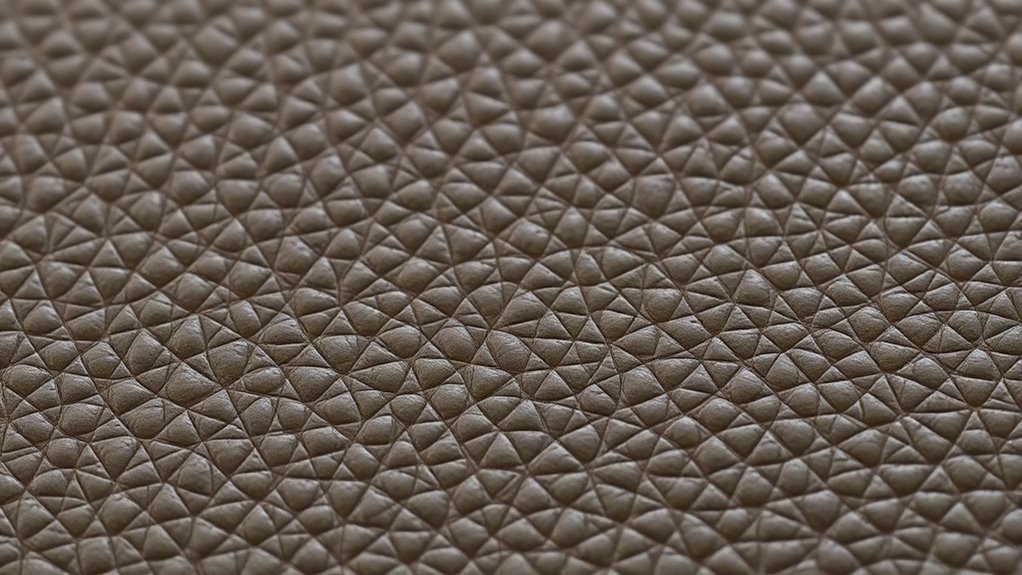
Understanding the environmental impact of vegan leather is essential when making sustainable choices. Vegan leather generally has a lower carbon footprint than traditional animal leather because it avoids livestock farming, which produces significant greenhouse gases. However, not all vegan leathers are equally eco-friendly; some use plastics like polyurethane, which aren’t biodegradable and can persist in the environment for decades. Biodegradability varies depending on the material’s composition—plant-based options tend to break down naturally, reducing long-term waste. To minimize your environmental impact, look for vegan leathers made from biodegradable materials and produced with eco-conscious methods. Being aware of these factors helps you choose products that align with your values, reducing pollution and conserving resources for a more sustainable future.
Frequently Asked Questions
How Do Vegan Leathers Compare to Genuine Leather in Durability?
You’ll find that vegan leathers often match genuine leather in durability, but synthetic durability varies. They tend to resist natural wear better over time, making them a practical choice. However, some vegan options may show signs of wear faster or crack more easily than genuine leather. Overall, quality vegan leathers can be quite durable, but it’s vital to take into account the specific material and how you care for it to ensure longevity.
Are All Plant-Based Vegan Leathers Completely Eco-Friendly?
You might wonder if all plant-based vegan leathers are eco-friendly. Not necessarily. While plant-based options often make eco-friendly claims, some use synthetic materials or chemicals during production, which can diminish their environmental benefits. Comparing plant-based vs synthetic vegan leathers helps you see that some are truly sustainable, but others may not be. Always check the materials and manufacturing methods to guarantee the product aligns with your eco-conscious values.
Can Vegan Leather Be Recycled or Reused Effectively?
Imagine your favorite vegan leather piece—what happens when you’re done with it? Recycling processes can sometimes recover fibers, but the reuse potential varies widely. Some vegan leathers are designed for better recyclability, yet others are tricky to repurpose due to mixed materials. You might be surprised, but in many cases, effective recycling depends on the product’s composition and available infrastructure—making sustainability a compelling, ongoing challenge.
What Are Common Chemical Additives in Vegan Leather Products?
You’ll find chemical additives like chemical binders and plasticizers in many vegan leather products. Chemical binders hold the material together, improving durability, while plasticizers make the surface more flexible and soft. These additives are common in faux leather to mimic the look and feel of real leather. However, they can sometimes raise concerns about chemical exposure or environmental impact, so it’s good to check product labels for specific ingredients.
Do Certification Labels Guarantee Ethical and Sustainable Vegan Leather?
You might think certification labels are a trusty map guiding you through ethical and sustainable vegan leather, but they’re not a guarantee. While they indicate adherence to certain ethical standards, they can be like a shiny coin—easily tarnished or counterfeit. Always dig deeper, research the certifying bodies, and understand their criteria. Certification labels are helpful signposts, but your own curiosity guarantees you truly find products aligned with your values.
Conclusion
When choosing vegan leather, remember that over 9 million tons of PVC are produced worldwide each year, contributing to environmental concerns. By understanding the materials and certifications, you can make more eco-conscious choices. Whether it’s plant-based options like cork or recycled textiles, your decisions impact the planet. So, next time you pick a vegan leather product, you’re not just selecting style—you’re supporting sustainability and reducing waste. Every small step counts toward a greener future.
